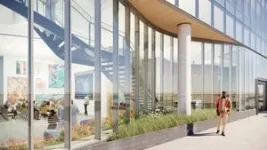Columbia University begins construction on New York City’s first all-electric biomedical research building
New building combines state-of-the-art medical research with a vision for a more sustainable future for science
2024-04-03
(Press-News.org)
NEW YORK, NY (April 3, 2024) – Columbia University Vagelos College of Physicians and Surgeons (VP&S) will begin construction on New York City’s first all-electric university research building in May. The new biomedical research building in Washington Heights is designed by Kohn Pedersen Fox (KPF) and will house eight stories of laboratories and research facilities, collaboration corners, living walls, and community engagement spaces.
The new biomedical research building will become the center of Columbia’s efforts to gain new understanding of diseases and develop next-generation treatments to some of the most significant threats to human health, including neurodegenerative disease, autoimmune disease, metabolic disorders, heart disease, and cancer.
This will be the first university-owned research building in New York City that does not rely on fossil fuels, and fully incorporates sustainability goals into all aspects of its design and operations. The new building will use significantly less energy than similar buildings of its kind, and is expected to perform 30% more efficiently than the ASHRAE 90.1 2010 standard, an energy efficiency benchmark for commercial buildings in the US.
“We are so proud to be laying the groundwork for this innovative new research building at Columbia. To create a space that will advance biomedical science, bring us closer to our local community, and help our medical center reduce its carbon footprint all in one is truly remarkable,” says Katrina Armstrong, MD, dean of the Faculties of Health Sciences and the Vagelos College of Physicians and Surgeons and executive vice president for Health and Biomedical Sciences, Columbia University. “Our purpose as a university is to drive discovery, educate next-generation leaders, and create inclusive partnerships with our community. This new space will offer the best environment for our people to do all three.”
The building’s laboratory floors will house 32 principal investigators and their teams of research technicians, postdoctoral researchers, and graduate students. The building will feature unique collaboration corners between research spaces that will help facilitate spontaneous interactions and idea-sharing among scientists. Biophilic elements such as green walls of living plants and the extensive use of natural, renewable materials will help reduce work fatigue and provide health and environmental benefits. The new building is accessible to community partners, providing ground level space to support community health engagement and research education and dissemination activities.
Research laboratories typically consume five to 10 times more energy per square foot than an average office building, according to the Department of Energy. At a time when scientists are increasingly concerned about the environmental impact of their research, Columbia’s new biomedical research building will set a leading example of a more sustainable future for science. To limit energy consumption, research spaces will incorporate many sustainable design strategies including high-efficiency lab fume hoods, demand-based controls for lab equipment, and air-source electric heat pumps.
Designed to use significantly less energy than similar buildings of its kind, the new biomedical building will outperform emission limits set by New York City’s Local Law 97 and help advance Columbia University’s Plan 2030 climate goal of achieving campus-wide net-zero emissions by 2050.
Columbia’s new biomedical research building is the latest in a series of climate initiatives by Columbia University, which includes the establishment of the Climate School in 2020 and launch of a global program to incorporate climate change into medical education.
END
ELSE PRESS RELEASES FROM THIS DATE:
2024-04-03
2 April, 2024, Sydney; In a world first, a team of international scientists including three Australians, Al-Aabid Chowdhury and Professor Simon Ho from University of Sydney, and Dr Jacqueline Nguyen from Australian Museum and Flinders University, have determined the family tree of modern birds and pinpointed the timing of their evolution. Their findings have been published today in Nature.
The largest study ever undertaken of modern bird genomes, the scientists combined genomic data of more than 360 bird species with data from nearly 200 bird fossils to reconstruct the most well-supported Tree of ...
2024-04-03
KEY TAKEAWAYS
Researchers from Mass General Brigham analyzed timing and location of gunshots in six of the most populated U.S. cities (Baltimore, Boston, Washington, D.C., New York, Philadelphia, and Portland, Ore.) from 2015-2021.
The team estimates that annually, approximately 12.5 million person-nights—the number of nights of gunshots multiplied by the number of people in earshot—are impacted by nighttime gunshots, and that those were more common in low-income areas in each city.
The noise of nighttime gunshots may have underrecognized and underappreciated effects on ...
2024-04-03
Picture this disaster scenario in the making: At an industrial plant, a pipe cracks, spraying a cloud of tiny droplets into the air. Workers, however, are in luck. Within minutes, a laser-based device the size of a small suitcase spots the cloud and tells safety crews what’s in it so they know how to respond.
That’s the vision behind a new project from a team of engineers and chemists at the University of Colorado Boulder, California Institute of Technology, University of California Santa Barbara, and three companies. It’s ...
2024-04-03
To better understand COVID-19’s spread during the pandemic, public health officials expanded wastewater surveillance. These efforts track SARS-CoV-2 levels and health risks among most people, but they miss people who live without shelter, a population particularly vulnerable to severe infection. To fill this information gap, researchers reporting in ACS’ Environmental Science & Technology Letters tested flood-control waterways near unsheltered encampments, finding similar transmission patterns as in the broader community and identifying previously unseen ...
2024-04-03
As any surfer will tell you, waves pack a powerful punch. Now, we are one step closer to capturing the energy behind the ocean’s constant ebb and flow with an improved “blue energy” harvesting device. Researchers report in ACS Energy Letters that simply repositioning the electrode — from the center of a see-sawing liquid-filled tube to the end where the water crashes with the most force — dramatically increased the amount of wave energy that could be harvested.
The tube-shaped wave-energy harvesting device improved upon ...
2024-04-03
Choosing paint for your home brings a lot of options: What kind of paint, what type of finish and what color? Water-based paints have emerged as “greener” and less smelly than solvent-based options. And they are often advertised as containing little-to-no volatile organic compounds (VOCs). But, according to research published in ACS’ Environmental Science & Technology Letters, some of these paints do contain compounds that are considered VOCs, along with other chemicals of emerging concern.
Paint consists of four ingredients: pigments, binders, additives ...
2024-04-03
A fungus devastating frogs and toads on nearly every continent may have an Achilles heel. Scientists have discovered a virus that infects the fungus, and that could be engineered to save the amphibians.
The fungus, Batrachochytrium dendrobatidis or Bd, ravages the skin of frogs and toads, and eventually causes heart failure. To date it has contributed to the decline of over 500 amphibian species, and 90 possible extinctions including yellow-legged mountain frogs in the Sierras and the Panamanian golden frog.
A ...
2024-04-03
When we communicate with other people face-to-face, we do so by maintaining a certain physical distance from each other. This space surrounding our body while interacting is called the interpersonal space (IPS), and maintaining adequate IPS is crucial for better communication.
Many studies have investigated the psychological and physiological changes that occur based on the presence of another person in the IPS during face-to-face interactions. These studies are based on the avoidance behaviour that we experience when a stranger invades our IPS, which manifests in the form of increased heart rate and discomfort. However, ...
2024-04-03
California, a state known for its aggressive greenhouse gas reduction policies, is ironically the nation’s greatest emitter of one: sulfuryl fluoride.
As much as 17% of global emissions of this gas, a common pesticide for treating termites and other wood-infesting insects, stem from the United States. The majority of those emissions trace back to just a few counties in California, finds a new study led by Johns Hopkins University.
“When we finally mapped it out, the results were puzzling because the emissions were all coming from one place,” said co-author Scot ...
2024-04-03
Menlo Park, Calif. — After two decades of work, scientists and engineers at the Department of Energy's SLAC National Accelerator Laboratory and their collaborators are celebrating the completion of the Legacy Survey of Space and Time (LSST) Camera.
As the heart of the DOE- and National Science Foundation-funded Vera C. Rubin Observatory, the 3,200-megapixel camera will help researchers observe our universe in unprecedented detail. Over ten years, it will generate an enormous trove of data on the southern night sky that researchers will ...
LAST 30 PRESS RELEASES:
[Press-News.org] Columbia University begins construction on New York City’s first all-electric biomedical research building
New building combines state-of-the-art medical research with a vision for a more sustainable future for science









